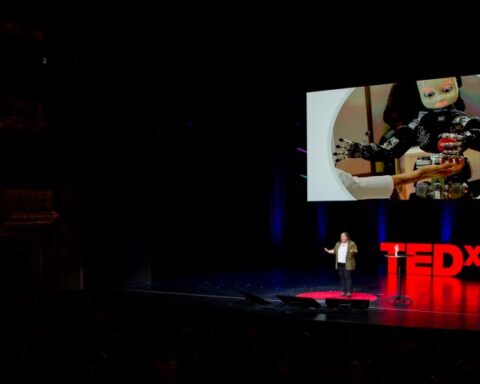“Jazz – you either hate it or you love it.” A sentence many of us have probably heard before as we first came in contact with the genre. Whether that’s true or not, once you have made a connection with this unconventional, historically laden kind of music it never lets you go.
Jazz is surrounded by a certain mysticism, maybe more than any other genre. It has captivated people since its early beginnings, and it continuously aids in creating community and innovation. With UN’s International Jazz Day fast approaching, remembering the genre’s legacy and future becomes increasingly important – not only regarding artistic and cultural matters but also science.
A Brief History of Jazz
Jazz’s ambiguous beginnings are still being debated. However, it officially originates in the United States. More specifically, it has its roots in the city of New Orleans in the late 19th century. After the abolishment of slavery, many previously enslaved African-Americans moved to cities and found work as musicians.
In its formative years, Jazz took influence from the clash of cultures that were prevalent in the vibrant city, including Caribbean beats as well as European harmonies. However, at the heart of it all is African-American culture. Jazz is composed of influences from spirituals, call-and-response practices (common in some African-American churches), blues, and ragtime, which preceded the rise of jazz as a musical genre.
Defining jazz is as difficult an endeavor as tracking down its exact origin story. However, the genre’s history is one of collaboration and innovation. By its very nature, jazz is constantly in flux. It’s not just the developments of the music industry causing jazz to be a subject of continuous change, but a formative element of the genre is improvisation.
Improvisation in jazz most often includes a soloist, as well as a group of musicians who repeat a certain rhythmic pattern and a succession of chords creating the base for the solo. Over this rhythm, the soloist plays an improvised melody, with each rhythmic cycle able to produce an entirely new sensory experience.

Among many other essential components for the genre, this element of improvisation and its variable nature make jazz especially interesting – not only for musicians or jazz enthusiasts. It is a collaborative project, a gesture of trust – allowing the music and the musicians to find their ways naturally.
This notion of collaboration and freedom in performance that the history of jazz entails is one of the main reasons why there is an entire day dedicated to the acknowledgment and appreciation of this extraordinary genre. The UN writes that “[…] this important international art form is celebrated for promoting peace, dialogue among cultures, diversity, and respect for human rights and human dignity, eradicating discrimination, promoting freedom of expression, fostering gender equality, and reinforcing the role of youth for social change.”
A Good Influence
A concrete example of this collaborative effort and the value of musical thinking is apparent, surprisingly, in physics. It is no secret that music and science have many intersections. Certain genres of music have been proven to stimulate the human brain and aid creativity and productivity alike.
As a listener of jazz and many other kinds of music, one can benefit from significant stress reduction and relaxation, which in turn may lead to greater performance capacity in other tasks.

However, this does not only apply to listening to music. As musicians engage in making music together, these positive effects are amplified. Additionally, improvising within a group while performing stimulates creative thinking, quick responses, and confidence.
In the last couple of years, the idea of “musical thinking” in science, especially regarding jazz, has attracted attention. So much so that there have been discussions to extend the concept of STEM education, which includes science, technology, engineering, and math.
The idea is called STEAM. It adds to the groundwork of scientific education by including the letter “A” for Art. Art, especially music, makes many of the complicated concepts of STEM more easily accessible to children who can grasp complex mathematical principles quicker if they train musical thinking before scientific thinking.
However, drawing on music to understand scientific ideas is not a new notion. Einstein himself accredited many of his greatest ideas to the breaks he took to play the violin – a concept called combinatory play.
Thinking Jazz, Reforming Science
Despite the cognitive advancements that musical thinking can generate on and off the stage, it also inspires scientists to think outside the box in their research. An example of this unconventional musical thinking in science is supplied by physicist (and jazz musician) Stephon Alexander.
His research in cosmology led him to the earliest beginnings of the universe as we know it – the Big Bang. He states that there is very little knowledge available on anything that preceded this formative moment for our galaxy. Still, in his research, he has been able to theorize his ideas through a musical analogy.
Alexander asked himself: “What if the universe was like a jazz solo?”
A jazz solo includes many different instruments which must be entirely in harmony to create exactly those sounds which jazz is known and loved for, and thus, allow the soloist to access his creativity freely.
Alexander’s research focuses on multiverse theory. Simply put, he argues that each molecule as it exists within the galaxy is fine-tuned, like an instrument, to create life as we know it. However, explaining how this fine-tuning came about is difficult.
To reason this, Alexander suggests that there might be an infinite number of Big Bangs – each with a similar rhythmic bassline but very different, improvised solos governing the fine-tunings of each multiverse. Thus, the Earth and life on this planet would simply be a creation of a lucky coincidence.
However unconventional this idea may sound to those unfamiliar with the innermost workings of cosmology, Alexander’s research is a paragon for cross-disciplinary research and the possibilities of improvisation.
In his TED talk, he explains the concepts of musical thinking and multiverses more clearly and makes a case for jazz as an inspirational force in the sciences.
Now, while the opinions on jazz might continue to be divided, its inspirational and bridging power that it possessed since its very emergence out of intercultural collaboration is obvious. It invokes mutual understanding, teamwork, and a certain sense of courage to try something new.
As the world changes, new challenges arise, and creative solutions are much needed, we cannot forget the importance and constructiveness of music. Jazz serves as an inspiration for innovation and creativity not only in art but in science as well.
Editors: Juxhina Malaj, Asli Ertem
Photo by Spencer Imbrock on Unsplash





